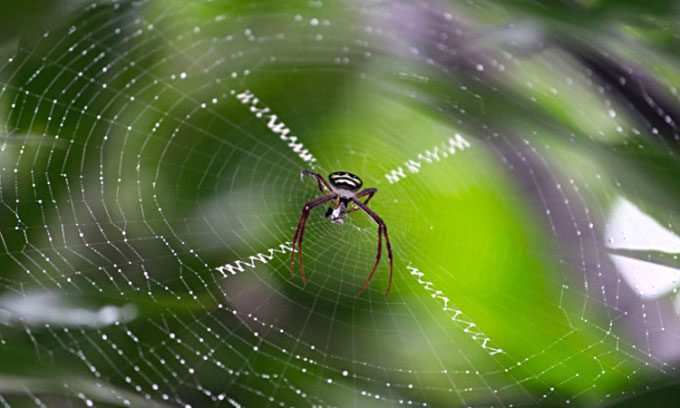Swedish scientists have discovered a way to use spider silk protein to enhance p53, a type of protein that fights cancer in humans.
Flexible yet strong, spider silk is one of the most remarkable materials in the natural world. With its superior characteristics, it has been utilized in numerous medical studies, ranging from gene therapy to reconstructive surgery.
In a recent study published in the journal Structure on March 14, researchers from the Karolinska Institute (KI) in Sweden uncovered another surprising application of this material: it helps stabilize and enhance a type of anti-cancer protein known as p53.

Spider web of the Argiope amoena species. (Photo: Ramakrishna Bhat)
The p53 protein plays a crucial role in protecting cells from cancer, partly by detecting and preventing disease-causing gene mutations. If a cell lacks functional p53, it can quickly become a cancerous cell that divides uncontrollably. As a result, researchers around the world are striving to develop treatments that somehow rely on p53.
“However, the problem is that cells only produce a small amount of p53 and then quickly degrade it because it is a very large and complex protein,” said Michael Landreh, the lead author of the study. “We took inspiration from nature, using spider silk protein to stabilize p53. Spider silk consists of long chains of highly stable proteins and is one of the strongest natural polymers.”
By attaching a small portion of synthetic spider silk protein to human p53 protein and then introducing it into cells, Landreh observed that the cells began to produce p53 in large quantities. The new protein also proved to be more stable than regular p53 and capable of killing cancer cells. Using electron microscopy, computer simulations, and mass spectrometry, the research team was able to demonstrate that the reason for this lies in how spider silk protein manages to structure the disordered regions of p53.
In the next phase, Landreh and his colleagues plan to study the structure of the protein in detail and how its different parts interact to prevent cancer. They also want to understand how cells are affected by the new potent p53 protein.
“Creating a more stable variant of p53 in cells is a promising approach to cancer therapy, and now we have a tool worth exploring,” emphasized Senior Professor Sir David Lane at KI, a co-author of the study. “Ultimately, we hope to develop a cancer vaccine based on mRNA, but before we can do that, we need to understand how to handle the protein in cells if large amounts of it could be toxic.”
The research at the Karolinska Institute is supported by the Swedish Foundation for Strategic Research (SSF), the Swedish Cancer Society, the Swedish Research Council, Vinnova, the Olle Engkvist Foundation, the Swedish Society for Medical Research (SSMF), Formas, and the Åke Wiberg Foundation.


















































